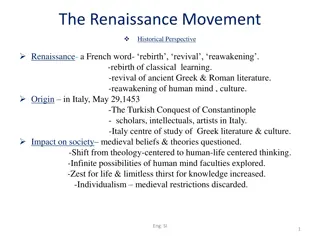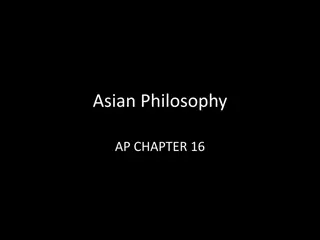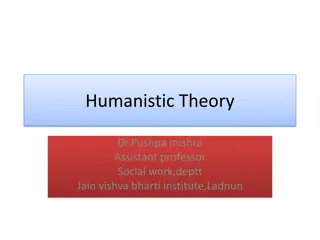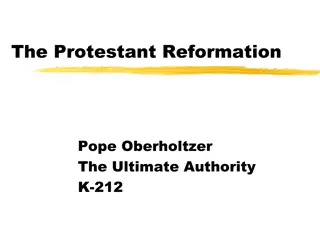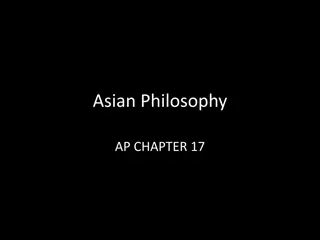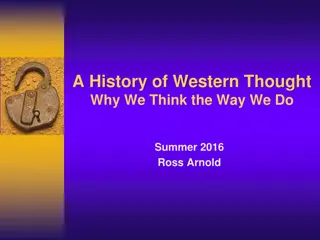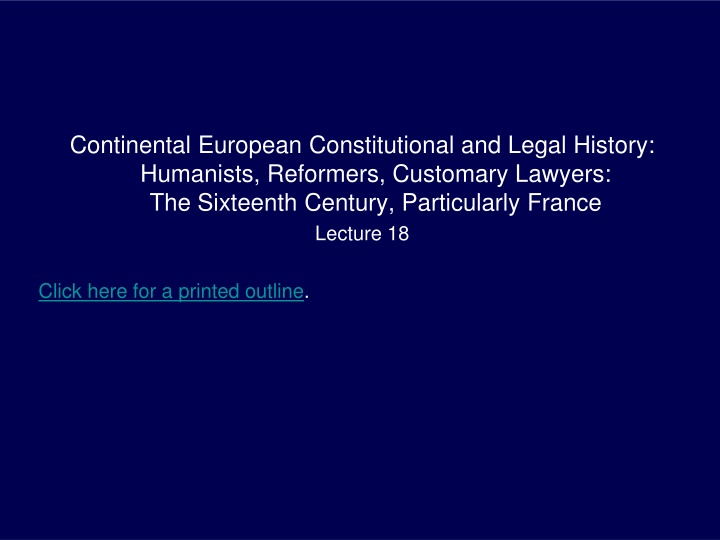
Continental European Legal History in the Sixteenth Century: The Lex Dei
Explore the significance of the Lex Dei, a work comparing Mosaic and Roman laws, in 16th-century France. Uncover insights into the author, historical context, and the relevance of this text to modern legal scholarship. Discover how this work sheds light on Roman law independently of Justinian's compilations and its impact on the discipline of comparative law.
Download Presentation

Please find below an Image/Link to download the presentation.
The content on the website is provided AS IS for your information and personal use only. It may not be sold, licensed, or shared on other websites without obtaining consent from the author. If you encounter any issues during the download, it is possible that the publisher has removed the file from their server.
You are allowed to download the files provided on this website for personal or commercial use, subject to the condition that they are used lawfully. All files are the property of their respective owners.
The content on the website is provided AS IS for your information and personal use only. It may not be sold, licensed, or shared on other websites without obtaining consent from the author.
E N D
Presentation Transcript
Continental European Constitutional and Legal History: Humanists, Reformers, Customary Lawyers: The Sixteenth Century, Particularly France Lecture 18 Click here for a printed outline.
Introduction: the Lex Dei The Lex Dei quam praecepit Dominus ad Moysen, the law of God which the Lord commanded unto Moses, also known as the Mosaicarum et romanorum legum collatio, the comparison of the Mosaic and Roman laws was unknown in the Middle Ages and first edited by the French humanist jurist Pierre Pithou, in a work published in Paris in 1572. Extracts are contained in part XVB of the Mats. Internal evidence suggests quite strongly that the Lex Dei was written in the fourth century, probably fairly early in the century. What is virtually certain is that the author was a Jew. What kind of a Jew is problematic. The work, though it is quite fragmentary, is important for modern historical scholarship, because it contains extracts from texts of Roman law that are independent of Justinian s compilations, which were made two centuries later. It gives us both texts that we otherwise would not have and allows us to see how much the compilers changed texts that we do have in the Corpus. The work is also fascinating for those interested in the history of the discipline of comparative law, though it must be confessed that the comparative method of the compiler is a bit hard to penetrate.
Introduction: the Lex Dei(contd) The contents of the work are about as far as one might imagine from what would be practically useful in the 16th century. We have already noted how the medieval glossators and commentators had created a procedural system that could be used in the Middle Ages. They began with some scraps and fragments of Roman law, but they quickly eliminated from them material that was irrelevant in their own day. What the Roman-law texts had to say about the use of gladiators as witnesses was deep sixed. What the Lex Dei has to say is raw Roman law. As you can see in the Materials, we hear once more about gladiators and freedmen as witnesses.
Introduction: the Lex Dei(contd) One can certainly understand why scholars of the ancient world, which the French humanists were, would be interested in this text. What s hard to understand is why they thought their work relevant to their own day. But they did think so, and why they thought so can be seen in the dedication of the first edition of the Lex Dei to Christofle de Thou, who was the first president of the parlement of Paris, roughly, the equivalent of the Chief Justice of the United States Supreme Court.
Introduction: the Lex Dei(contd) There is no single reason why I offer these remains of old authors of the law to you, most generous president, but this one seems particularly just: that it was fitting that these [remains] (which to some may perhaps seem to be brought forth against the interdict of the prince Justinian), be defended by some more holy [i.e., respected.] name against the calumnies and foolishness of most ungracious men, who either pretend [not to know] or in fact do not know that whereas he prohibited comparison and reading aloud in court among his people, we in truth keep the majesty of the Roman laws so courteously that we nonetheless allow them to have no license [i.e., authority] among us except what we concede to their reason and equity, not to their authority and sanction. Whose name, in truth, could be chosen that would be more noble for this defense than yours? Since, finally, under your presidency this purer jurisprudence has been received for the court s use, and since you so hold and so guide the rudder of our law in that highest tribunal of Gaul, that like that very great man of old, you can not unworthily be called the soma [body] of the Senate [parlement] and, indeed, in some sense, the empsychos nomos [the law in spirit]. (cont d on next slide) .
Introduction: the Lex Dei(contd) And also that you can claim by a certain right that is yours a share in our works, of all of which you are the chief patron, or rather father, when your highest humanity clearly persuades you that the name of goodness is more pleasing to you than the name of power. . . . May you therefore receive this gift from a man most dedicated to your virtues, not any great thing, but one nonetheless that may at this time benefit you and through you the public utility, you who will perhaps some time in the future be even more distinguished as a man to whom God has given the spirit of a good citizen, and whom He confirms, increases, instructs, aids, protects out of His singular clemency in every way he can. Fare you well, most generous man. Paris, the Kalends of October, MDLXXII [i.e., 1 October 1572]. This is obviously quite different from anything that we have seen before, and it will take the rest of a long lecture to put it in a context that makes sense out of it. .
Italian Renaissance Humanism If I were asked on an exam when the Italian Renaissance began, I would say that it began in 1860 with the publication of Jakob Burkhardt s The Civilization of the Renaissance in Italy. That statement is too radical. Unlike feudalism, which is a word that did not appear until the 17th century, renaissance is a word that some people in the 14th, 15th and 16th centuries used to describe what was happening. The problem is that it is only some people, and we call these people humanists, particularly when we are talking about written expression. There certainly is something about the literature and art of 14th and 15th century Italy that is distinctive, different from what had gone before, and different, at least for a while, from what was going on in northern Europe. We distinguish humanism from the scholastic and the gothic, depending on whether we focus on verbal or visual expression. It is a complex movement, perhaps too complex to encompass in a single word.
Italian Renaissance Humanism (contd) Direct influence of the humanists on the lawyers comes relatively late. The 14th and 15th century Italian humanists tended to regard the jurists as beyond hope. Jurists Latin was criticized as barbaric; their scholarship as insufficiently historical and insufficiently classical; their texts as hopelessly corrupt. One can see some influence of humanist political ideas in some of the works of the conciliarists. Lorenzo Valla s (1407 1457) demonstration that the so-called Donation of Constantine to the papacy was a forgery made long after Constantine confirmed what some jurists had probably suspected for some time. By and large, however, training as a jurist called for a degree of specialization, a tunnel vision, that made the jurists as a profession, for a while, largely impervious to humanistic ideas. The humanistic movement did not really begin to affect the lawyers until the late 15th century, and humanist jurisprudence did not have a substantial effect until the 16th century. By that time the world was changing, and we must sketch those developments before we return to the humanist jurists.
The sixteenth century in general When we last considered the political and institutional history of Europe at the end of the fifteenth century, we suggested that we were on the brink of something new. Louis XI had succeeded in establishing royal power over much of the territory of modern France; the crowns of Castile and Aragon had been united under Ferdinand and Isabella; the papacy had succeeded in shaking off the conciliar movement, and a series of Renaissance-style princes were occupying the chair of Peter. Something new did happen, but the combination of events that brought it about were totally unpredictable: First, Columbus found the Indies. At first it had very little effect, but relatively soon, certainly by the 2d half of the 16th century, wealth from the Indies was to contribute significantly to the power of Spain. Second, Maximillian I, the Hapsburg emperor of Germany, married Mary of Burgundy, the daughter of Charles the Rash, and acquired with it suzerainty over much of the Low Countries and a claim to Burgundy. Maximillian s son, Philip, married Joanna, daughter and heiress of Ferdinand and Isabella. Philip died young, and Joanna was mad, or at least contemporaries thought she was mad. In 1516 with the death of Ferdinand, Joanna and Philip s son became Charles I of Spain. In 1519, he became Charles V, the Holy Roman emperor.
The sixteenth century in general (contd) Third, in 1517, an obscure Austin canon named Martin Luther nailed 95 theses to the door of the church at Wittenberg. The unity of Western Christianity was broken, a rent that has lasted to this day, although, of course, no one at the time knew it. Fourth, an event in the history of technology: the invention of movable type in the mid-fifteenth century. Printed books are like literacy; they spread slowly. The fact, however, is that by the end of the 15th century the Bible, many of the church fathers, much classical literature, and both major corpora of the learned law with the gloss had been printed, and many of the 14th and 15th century legal commentaries. In the 16th century there was a veritable explosion of printed books, and law and religion are the major topics of printed books.
The sixteenth century in general (contd) Much has been written about the Protestant Reformation or the Protestant Revolt, as some call it, and I can hardly do justice to the topic here. We will speak later of the political ideas of the Protestants. These have obvious relevance for our overall theme. It is sometimes suggested that Protestant theology is also related to legal developments in the early modern period, and that may be, but the relationship between such ideas as justification by faith and predestination to the law is complex. Except as it concerns Protestant political ideas, the relationship of Protestant theology to the law is not obvious. Harold Berman has argued that there is a connection, and I do not want to be accused of insulting the dead lion, but if you write a book that focuses on the 16th-century Protestant jurists of Germany and do not say a word about the jurists of France of the same century, both Catholic and Protestant, you are, to put it mildly, stacking the deck.
The sixteenth century in general (contd) It is frequently said that the cause of the rise of the Protestants was the refusal of the Roman papacy to reform itself, and there was certainly much about the 15th and early 16th century papacy that called for reform. But the papacy had been in need of reform before. Indeed, reform is an endemic theme in Christianity and many other religions as well. The Renaissance papacy was certainly no more in need of reform than that of the late 10th and early 11th centuries, and that papacy was reformed in what we call the Gregorian reform, not without conflict but without a fundamental breach in Christian unity. The papacy and many church institutions were also reformed in the 16th century, a reform that we associate with the Council of Trent (1545 1563), a reform that is sometimes called the Counter- Reformation. But that reform did not restore the unity of Christianity. So I would suggest that the undeniable need for reform at the beginning of the 16th century is not a sufficient explanation for why Protestantism succeeded in breaking the unity of Christianity. (We move now on the outline from events to the reformers.)
The sixteenth century in general (contd) Let me try to sharpen the focus at bit more. In the late 14th century John Wyclif in England called for reform and espoused a number of ideas that were later declared heretical. His movement got no place, although it was recalled in the 16th century. In the early 15th century Jan Hus in Bohemia called for reform and may have espoused ideas that were heretical about that there can be more doubt. His movement got no place, although it, too, was recalled in the 16th century. Why did the reform movement accompanied by heretical ideas espoused by Luther, and later in somewhat different forms by Zwingli and Calvin, succeed in breaking the unity of Christianity when Wyclif s movement and Hus s had not? With some diffidence may we suggest that the reasons are political rather than religious?
The sixteenth century in general (contd) The uniting of the crowns of Spain and the Empire in one man created a frightening situation for the independent kings and princes of Europe. The situation was a particularly awkward one for France. Both Charles VIII and Louis XII of France had been engaged in expansionist wars in Italy, sometimes with the backing of the pope, sometimes with his disapproval. Charles V, with bases in Spain, Southern Italy, and the Low Countries, and with claims to Burgundy looked as if he had France surrounded. In addition, he had extraordinary claims the New World. From the point of view of the princes of Germany, Charles was also a threat, a threat of a much more powerful emperor in a world that had long been used to imperial figure- heads.
The sixteenth century in general (contd) The struggle between Charles and Francis I of France, between Hapsburg and Valois, did not go well for France. Francis I was captured by Charles and was forced to sue for peace, but Francis never lost any French territory, and the struggle succeeded in diverting attention from the religious situation in Germany. What happened was that while the emperor and French king were jockeying for power in the Mediterranean world, the northern German princes embraced Luther and Protestantism. The same happened in parts of Switzerland, for similar reasons. Protestantism, then, became a way to unite smaller areas in opposition to the emperor. I won t be so cynical as to suggest that had Charles V become a Protestant instead of remaining staunchly Catholic, the margrave of Brandenburg and the elector of Saxony would have remained true to the old religion; the phenomenon is too complicated for that. What I am suggesting is that because the elector of Saxony and the margrave of Brandenburg became Protestants, Protestantism succeeded where other heretical reform movements had failed, and that their becoming Protestant was, at least in part, an expression of their opposition to Charles. Others were to follow.
The sixteenth century in general (contd) Charles V was not a stupid man, and one of the smartest things that he did was to resign both his thrones while he was ahead in 1556. The Peace of Augusburg had been achieved; the Council of Trent had had two of its three major sessions; the Counter-Reformation was launched. He probably realized that the area he had inherited was too vast for any one man to govern. He may also have realized that foreign monarchs had had their day. Although he was brought up in Belgium, the Belgians to this day call him Carlo Quinto rather than Charles Cinq or Karel Vijfte, the two native languages in Belgium. But Charles V was also regarded as a foreigner by the Spanish. Charles left Spain to his eldest son, Philip II, who had been born and raised in Spain and hardly ever left the country, even to marry Mary Tudor of England. Until the defeat of his Armada in 1588, Philip was the most powerful monarch in Europe, and the second half of the sixteenth century is called Spain s Golden Age. Charles left the empire to his brother, Ferdinand I, who began the line of the Austrian Hapsburgs, who were to sit (with one brief interruption) on the imperial throne until 1806.
The sixteenth century in general (contd) I have said that a necessary if not a sufficient condition for the initial success of Protestantism was opposition to Charles V. Charles himself, at the peace of Augsburg in 1555, was able to hold the Empire together by conceding the principle that religion would follow the faith of the prince of each territory, the famous principle: Whose region it is, his religion is followed, cujus regio eius religio. It was an uneasy unity, however, one that was to be tested in thirty years of bloody warfare at the beginning of the 17th century. It was also a unity in which most real power was exercised below the level of the empire. I would like now to turn, however, to the second half of the 16th century and to a much more powerful monarchy, France, to see how the religious changes of the first half of the century played themselves out.
The sixteenth century in general (contd) France was, of course, opposed to Charles V, and yet France remained Catholic. It was able to do this because for a long time Catholicism had not meant in France subordination to any foreign power. The papacy was controlled by the French throughout most of the 14th century. In the 15th century, with some exceptions, the French kept their distance. A long tradition, known as Gallicanism, had kept ecclesiastical affairs in France largely in the control of the French, and at the higher levels, in control of the French king. The control of the French over the Church was strikingly reaffirmed in the time of Francis I.
The sixteenth century in general (contd) I have said that Protestantism is complicated, and no where is it more complicated than in France. There were no French reformers in the first wave of Protestants. The intellectual influences on the French reformers came largely from Switzerland although their leader was a Frenchman named Jean Calvin. Hence it was a brand of Calvinism rather than Lutheranism that the French Protestants, who came to be called Huguenots for unknown reasons, adopted. Huguenots were particularly strong at the university of Bourges, where many of the French humanist jurists taught, and where Jean Calvin had been a student for a brief period before going to Geneva. Calvinism began to spread rapidly in France in the 1550s. It seems originally to have been an exclusively religious movement, but it soon became involved in a dynastic struggle for the control of the French throne.
The sixteenth century in general (contd) Henry II had died young of wounds received in a tournament. He left behind three young and singularly unattractive sons who were firmly in the control of their mother Catherine de Medici. The Catholic nobility formed a League, the ostensible purpose of which was to keep the country Catholic, but the means which they used involved controlling Catherine and the throne. As it became more apparent that the Valois line would die out, attention was focused on the Bourbon house, the heirs apparent to the throne. In the meantime the power of the Protestants increased. Various small wars, assassinations and attempted assassinations led Catherine to authorize a massacre of the Huguenots, the famous St. Bartholomew s Day massacre of 24 August, 1572. Ultimately, however, Henry III was assassinated, and the throne fell upon Henry of Navarre, the head of the Bourbon house, and a Protestant. In order to achieve the throne he converted to Catholicism. Paris vaut une messe Paris is worth a mass. (He may never have said it, but the remark is in character.) In 1598 he promulgated the Edict of Nantes, the first genuine piece of religious toleration within a kingdom.
The beginnings of humanist jurisprudence We said above that the humanist movement did not really begin to affect the lawyers until the late 15th century, and that humanist jurisprudence did not have a substantial effect until the 16th century. Here, and I think it is significant, the key figures did not work in Italy, although one of them was an Italian. Andrea Alciati, an Italian jurist trained in the manner of the commentators by Jason de Maino, came to teach at the university of Bourges in France. Although his lectures were largely given in the old style he read the text to the class and commented on it what he said and particularly what he wrote was thought of as strikingly new. He largely ignored the gloss; indeed he largely ignored what had gone immediately before him. Rather, he sought to apply the new methods of history and grammar to the explication of the texts before him. His teaching was immediately successful and inspired a number of followers. These followers soon became embroiled in what became for France a deeply divisive time, the Wars of Religion. The humanist movement in jurisprudence is complicated, and the school of jurists who followed the French method, the mos gallicus, were united by little except their determination not to follow the traditions of the commentators, the Italian method, the mos italicus. First, however, we must say something about the pieces of the humanist tradition that the jurists picked up.
The beginnings of humanist jurisprudence (contd) We have already mentioned Lorenzo Valla and his contempt for lawyers. His contribution to jurisprudence was in demonstrating, by methods of textual criticism that were becoming dominant in his time, that the Donation of Constantine could not have been written in the 4th century. In the first place, the vocabulary that it uses is not the vocabulary of genuine 4th century imperial edicts, of which a number survive. Secondly, the manuscript tradition showed that the document was not recorded before the 8th century. (It is now dated around 730.) This focus on manuscripts and textual criticism was carried much further and to greater effect in the generation after Valla by Angelo Poliziano (1454 1494), who was the first person since the 11th century seriously to examine the codex Florentinus, the late sixth or early seventh century manuscript of the Digest. He did so in order to determine if the Vulgate text of the Corpus Iuris Civilis was accurate. Poliziano was particularly effective because of his knowledge of Greek, for there is quite a bit of Greek in the Corpus Juris Civilis, and quite a bit more that can be best be explained on the basis of Greek sources. There is, for example, a huge work called the Basilica, which is a translation of the Digest into Greek, with considerable commentary.
The beginnings of humanist jurisprudence (contd) Pride of place, however, among the early humanist studies of the law must go to Guillaume Bud and his famous Adnotationes ad pandectas (Notes on the Pandects) published in 1507. Bud was, as his name implies, a Frenchman. He was not trained as a jurist but as a humanist. He approached the Corpus with a profound knowledge of the Classical languages and of Roman history. He demonstrated, much to his great delight, that much that was in the gloss could not possibly be right, granted the language and the history in which the material was set. Bud corresponded with Alciati about the techniques of humanist philology with legal texts, but Alciati, in many ways, rejected Bud s teaching. Alciati continually taught that juristic texts must be studied professionally.
The beginnings of humanist jurisprudence (contd) It is not enough to know that Cicero never uses a word in a particular way; one must also recognize that the Roman jurists, of whom Cicero was not one, had their own technical vocabulary. Further, Alciati rejected the claim that the humanists who may have been joking made when they said that the modern jurists were violating the law when they interpreted Justinian s text. (Recall that Justinian had forbidden commentaries on his text.) Rather, according to Alciati, interpretation is essential to understand the meaning of the text. Grammar and philology are handmaidens of interpretation. Nonetheless, like his contemporary and friend Desiderius Erasmus with the Bible, Alciati s effort was essentially one at getting at the original meaning of the text, shorn of its centuries of commentary and aided by the tools of history and philology. In this regard Alciati was much like his contemporary Ulricus Zasius, who brought many of the same methods to the teaching of Roman law in Germany. Zasius efforts, however, were not to have the immediate practical effects that Alciati s were to have, and this for political reasons with which we will treat briefly below.
French humanism and homologation of custom What I want to do now is staggering in its superficiality, but I think it needs be done so that we have some idea of where the traditional historiography suggests we are going. The traditional historiography sees virtually every development in the law from 1500 to 1800 as being one step on the road to codification. No place is this characteristic of the historiography more notable than it is in France. This is for good reason. A great deal of what happens in the 16th, 17th and 18th centuries in France can be viewed as preparatory for codification.
French humanism and homologation of custom (contd) Focusing on codification in any one country runs a number of risks, not the least of which is that it tends to make us lose sight of the common elements in the intellectual tradition that are Europe wide and also the curious moves that take place from one intellectual center to another. In the MA we noted the transnational character of the intellectuals. This characteristic continued during the early modern period despite the increasing importance of the nation as an entity. The continued importance of the study of Roman law in the universities, and, to a lesser extent canon law, was, if not a cause of this phenomenon, certainly an aid to it. We might also mention that well into the 18th century intellectuals wrote in Latin, at least some of time. To focus, then, on France and on the main elements in the story: Codification in France comes about in stages that are best seen by setting what is going on legislatively side by side with what it going on in the academies and in doctrinal writing by the practicing lawyers. The outline lays out the main pieces. .
French humanism and homologation of custom (contd) Chronologically the customs come first; indeed, we have seen that they go back to the Middle Ages, to a point when French legal development is virtually indistinguishable from English. The earliest event on our outline is the ordonnance of Montils les Tours of 1453, which calls for the redaction of the customs of the customary jurisdictions, i.e., those in roughly the northern 2/3 of France. The redaction movement, however, really doesn t take off until the 16th century, at which point the French universities are fully into the humanist movement. The 16th century in France sees three parallel intellectual developments, all of first importance for our story. (1) The French humanists are the leaders in editing texts that seek to restore the true antiquity. (2) The French commentators on the Roman law lead the way in the systematization of the classical Roman law. (3) The customary lawyers begin the slow process of bringing the customary material as it is being redacted under an umbrella of principle largely, though not exclusively, derived from Roman law..
French humanism and homologation of custom (contd) Parallel with, though somewhat later, comes a movement in the direction of systematization by means of royal ordinance or edict, the so-called grandes ordonnances. We ll talk about those in the next lecture. In the meantime, the intellectual effort had largely petered out in France. Domat in the 17th century and Pothier in the 18th are regarded as giants because there is so little else with which to compare them. But the commentaries of Domat and Pothier were highly influential when France ultimately came to codify at the end of the 18th century.
French humanism and homologation of custom (contd) So let us turn to the codification of custom. Perhaps we ought to call it by its proper name homologation of custom, homologation here means sanctioning . The call for codification is old. I goes back even before Charles VII. Charles was, as you may remember, the Joan-of-Arc king, the man who finally pushed the English out of France in 1453. That the call for codification of custom should come to the fore at that time, at a time of political triumph, is not surprising; law has long been thought to express the unity of the people, and France was anything but unified politically in 1453. The forces that underlay the move for codification are complicated. They include the professional lawyers, who wanted to have something to hold onto, and who also didn t want to be subject to the enqu te into custom, a process which in some areas meant that laymen came in and told the lawyers what the custom was. They certainly included some royalist forces who suggested that the king could control the customs, but he must know what they are before he can control them, but they also include some of the bourgeois who sought certainty in the law particularly in those areas where there had never been a private redaction of the custom. On the other hand, the custom was a source of local pride and a source of privilege among those who were privileged.
French humanism and homologation of custom (contd) They allowed a non-professional element to survive, an element of localism, even if the element of localism was the localism of local oligarchies. The resulting system had to appear to be neutral, and in almost all areas the customs were redacted by royal commissioners who were told what the customs were by assemblies of the local estates. In some areas there was considerable participation of local professionals, judges and lawyers; in other areas, lay people predominated. Sixteenth century Frenchmen cared intensely about their customs (compare the tenacity with which the Spanish stuck, and in some areas still stick, to their local fueros). We have already said that the process of redaction of custom invariably changes a truly customary law. One might doubt how customary the law was in 16th century France but in some areas it probably still was. Some of the 285 areas that had redacted customs were very small, out-of-the-way places. The process of redaction, even if it was totally in the control of the estates, changes the law. What one has after redaction is not the same as what existed before. But because the redaction took place under the supervision of royal commissioners, there was tendency toward harmonization, even where it was unconscious. If I am working on my fifth commission, I am likely to ask the questions that the four previous juries have answered, even if that means that the juries in the fifth area will be answering a question that never occurred to them before.
French humanism and homologation of custom (contd) We have spoken of the forces that lay behind the move for redaction of custom in the 15th century, but in fact virtually no customs were redacted in the 15th century. That the redaction took place and that it was as complete as it was is largely the work of one man, Christofle de Thou, the dedicatee of Pithou s Lex Dei. Part of the reason for de Thou s interest in seeing to it that the job was done was purely professional. A collection of codified customs made the job of the parlement of Paris, of which he was the first president, easier, or at least doable. It was, as you will recall, a court that largely devoted itself to hearing appeals from the customary regions of France. Part of it, however, had to do with a phenomenon that we re going to see more of. Fear that if the job weren t done French customary law would disappear in favor of Roman law. Part of the fear of Roman law was the old dislike of its association with the emperor, but the answer, as Pithou points out, had long been found to that: rex Franciae imperator in regno suo: the king of France is emperor in his own realm.
French humanism and homologation of custom (contd) De Thou well knew this, and I suspect that his fear of Roman law was much more like the fear of some of the English lawyers in the same period. French customary law was an intellectual mess, and in an intellectual age messiness was not desirable. The French customary legal profession was in danger. Someone would come along and say that the way to get a unified orderly legal system was to junk the customs entirely and adopt Roman law. What de Thou feared then was what has been called a reception of Roman law. There was even a suggestion that this had happened in the Empire with the establishment of the Reichskammergericht in 1495, a tribunal that was supposed to apply Roman law rather than attempting to apply the multiplicity of German customs. Recent work with the actual decisions of the Reichskammergericht suggests that customary law may have remained pretty important in the 16th century, and that is probably a partial answer to the question that I posed on above as to why Ulricus Zasius did not have the effect in Germany that Alciati had in France.
French humanism and homologation of custom (contd) If the codification of custom occurred as a result of the efforts of de Thou, it was able to hold its own intellectually because of the efforts of lawyers who had been trained in Roman law. We have already said something about legal humanism and about the leading role that France played in it. We have already mentioned Alciati and on the lawyers at the University of Bourges to illustrate the beginnings of the movement. Later, we will say something about the political thought of lawyers in the same period. Let us see where legal humanism went from the time of Alciati for those lawyers whose principal concern was not political theory. What follows is a run- through of the names listed on the outline as Alceatani , followers of Alciati.
French humanism and homologation of custom (contd) The immediate successors of Alciati as professors of law at the University of Bourges were guinaire Baron, Fran ois Douaren, and Jacques Cujas. They could not have been more different, and to say that they, particularly the first two, did not get along is to put it mildly. I have characterized Baron as a comparativist, Douaren as a systematizer and Cujas as an editor of texts. That certainly describes the principal thrust of their work, and it allows one to see how the line of editors of text will run from Cujas to the Pithou brothers, to the Godefroi, father and son, to the elegant jurisprudents of the Dutch school of the 17th century and, more ultimately, to the legal historians of today. But Cujas was not only the teacher of the Pithou brothers; he was also the teacher of Loisel and of Pasquier, and that should immediately give us pause in thinking that the editors of texts of the 16th, if not the 17th, century were pure academics, despite the fact that the Pithou brothers and the Godefrois did not teach.
French humanism and homologation of custom (contd) Similarly there is nice line that runs from Connan who proposed the first classification scheme for Roman law to Douaren and Doneau who worked on the refinement of the systematic treatment of Roman law, with strong influences from natural law, and whose work ultimately leads to Domat, the civil laws in their natural order, as he entitled his great book. But Douaren and Doneau were also interested in history. Both of them taught feudal law at the university of Bourges, as well as Roman law. Their Protestant leanings fit uneasily with the Jansenist Domat and much more comfortably with the historian Hotman.
French humanism and homologation of custom (contd) The fact is that these guys defy easy classification. It is better to look at trends in their thought, themes that they play with together, one emphasizing one more at the expense of the other. Let us try to outline some themes and let them fall where they may: There is no question that the French displayed a considerable interest in system. Their system might come directly out of Roman law texts, as did Connan s, or it might come out of study of the customary law, as did Dumoulin s. The two could not have been more different in their views about what was an appropriate law for France. Dumoulin opposed any direct importation of Roman law into French law. Connan took a much more nuanced position on the issue. (None of the Romanists argued for direct importation; Doneau probably comes the closest.) But Connan s and Dumoulin s interest in system overarched the specific body of law from which they derived that system. The initial efforts of the customary lawyers at system owes relatively little to Roman law (see Mats., p. XVI 7).
French humanism and homologation of custom (contd) The outline lays out titles of the custom of Paris of 1580, which we looked at before the break. Thinking about them in terms of the Roman system we might note: Mixture of public and private. Fiefs, seigneurial rights, public proclamation, all being public law or mixed public and private. No attempt to follow J.I. Is there an order at all? tit. 1 3 roughly correspond to the Roman law of things tit. 4 9 may be seen as belonging to the law of actions. (The retrait being viewed as an action; servitudes are out of order, but the report of juries makes sense as being law of actions.) tit. 10 15 persons and succession combined tit. 16 pure public law The achievement is being able to organize things in titles, the middle- level generalizations that are also characteristic of English law. Almost total absence of the law of obligations The one provision on animals (article 91) is miles from Roman law in what it says about the animal but very close in the classification issue that it raises.
French humanism and homologation of custom (contd) If it did nothing else, the effort made clear that much was missing from the customary law. Systematization could fill in those gaps with Roman categories and Roman law, as was the tendency of Gabriel Argou in the late 17th century, or it could search the customary law for material to fit into the Roman system, as is illustrated by Antoine Loysel s Institutions, or it could leave the system of customary law intact, as did Guy Coquille, both of whom came much earlier in the 17th century. We will deal with these authors in more depth in a later lecture. The tendency increasingly over time was to impose the system of Justinian s Institutes. In part, this was owing to the fact that that made it easier for university-trained lawyers to learn the customary law. This is one reason that Argou s treatise was so popular. In part it was because the system of the Institutes was felt to correspond to a natural classification. Whatever the reason, the system itself was much broader than its contents. One could argue for Roman law and use the classification of the Institutes, but one could equally well argue for customary law using the same classification.
French humanism and homologation of custom (contd) The humanists were nothing if not broad-gauged. Their interest in history led them at once into the depths of classical textual criticism and into the wildest speculations about Celtic law and Germanic law. There is no question that they debated fiercely among themselves about the wisdom that was revealed in their sources, some arguing as Pithou does in his epistle to De Thou, that by examining how Roman law actually reflected the society in which it was found one could learn principles for contemporary French society; some arguing, as Cujas seems to have at times, that the discovery of the real Roman law would also involve the discovery of what should be restored; some arguing, as Hotman did, that the study of the real Roman law would show how badly Justinian had compiled his texts and how a return to the Gaulish and Germanic law would be truer to the French spirit. The range of possible positions was great, but they all believed that that there was a point to be learned for modern law from the study of the past. Most of them, too, though not all, were willing to concede that there were non-Roman materials that were worthy of study, even if they did not do it themselves.
French humanism and homologation of custom (contd) It is for this reason that a recent scholar named Donald Kelley has been able to suggest that Baron and Cujas really belong together and that three of the four intellectual streams that issued from them jointly, the editors of texts, the historian-theorists, and the customary lawyers are really part of the same movement. Only the systematizers, with their tendency toward abstraction, belong, in Kelley s view, in a category by themselves. I m not sure that that is right. Part of my reason for so thinking will not become apparent until a future lecture when look at the institutional treatises of the slightly later period. But I think that we have already said enough to indicate why the systematizers are so important for all three efforts, the historical, the comparative, and the customary. The historical effort and the customary are initially efforts to recover what had been lost or was in danger of being lost. In the case of the Corpus Iuris, the text was there but, in the humanists view, the proper understanding of it had been obscured by centuries of commentary that had made the texts mean things that they had not meant originally. In the case of the customary lawyers the effort was one, in many cases, of producing a text where no text had previously existed.
French humanism and homologation of custom (contd) The result of the former effort could have been to make Roman law irrelevant to sixteenth-century France; the result of the latter effort could have been to enhance the divisions between areas of customary law, to lead to fragmentation rather than unity. Neither happened. It did not happen in the first place because the comparatists showed first the substantial areas of commonality in the French customs and ultimately the substantial areas of commonality between the customs and the Roman law. If one stops there, however, one ends up with a body of rules that may or may not be interconnected. It was the function of the systematizers to show what the overarching interconnections were, first in Roman law and then between the Roman law and the customs. Codification not only in the late eighteenth century but also in the seventeenth century was to combine Roman law and customary law. It would not have been possible to do this in a coherent way were it not for the fact that the systematizers had produced a structure that was broader and more abstract than that which the ancient Roman lawyers had themselves produced.
Political thought in the sixteenth century Let us now go to the section of the outline called Political Ideas . I d like to suggest that what was different about the 16th century goes deeper than political and religious events. Not only was what was happening different but people were thinking about it differently. Political thought, in which the lawyers were deeply involved, fundamentally changed in the 16th century. Political thought in the 16th century was extraordinarily varied, but if I were to characterize what was new about it, I would follow a remarkable book by a man named John Figgis, now more than a century old, and say that it was the invention of the territorial nation state. Medieval political thought had given state-like powers to the church, had, at times, conceived of all Christendom in terms like that of a modern state, had struggled with the relationship between ecclesiastical and secular authority, but had never really conceived of the territorial nation state in the modern sense. Absent the nation-state one cannot have public law in the modern sense. Now the middle ages knew plenty of law. It conceived of law both as above and below kings, princes, and popes, but it never really came to a notion either of purely positive law or to a sharp distinction between public and private law. This is really all the more remarkable when we consider that both ideas seem, at least to us, to be fundamental to Roman law.
Political thought in the sixteenth century (contd) Now 16th century legal and political thought is not one simple line leading from the Middle Ages to Jean Bodin, to whom is attributed the idea of secular sovereignty. It is not even clear that Jean Bodin is where it is heading. Each group of thinkers has its own bias, related to the political situation in which they write, but also determined by the nature of the ideas that they are employing. In some ways the ideas proved more intractable than the politics.
Political thought in the sixteenth century (contd) Let us begin again with 15th century conciliarism. The council failed. It failed because it failed to deal justly with the problem of Jan Hus, because attention was turned away from it once the pope again became one, and because it lost all credibility when it appointed the last anti-pope. But it left a legacy, drawn immediately from Marsilius of Padua, and less directly from Ockham and Wyclif, for civil societies the constitutive nature of the people, Walther Ullmann s famous ascending theory of political power. Now we must be careful here. The constitutive nature of the community has little or nothing to do with individual rights. That is a separate idea, one that may have existed at the time but which could not develop into its modern form until the idea of the state had been developed. The conciliarists also left an important legacy of instrumentalism.
Political thought in the sixteenth century (contd) Jean Gerson and Pierre d Ailly were both, in some sense, utilitarians. The salvation of the people is the supreme law, salus populi suprema lex. The necessity of the church knows no law. This was their answer to the arguments that no one could judge the pope and that only the pope can call a council. The schism, they said, is destroying Christianity; it must be stopped. We still have not reached the idea of the state. But the conciliarists left elements that could be turned into the idea of the state. Nicholas of Cusa (Kues) (1401 64) is perhaps the last significant political thinker to see Christendom as a single organic unity with pope and emperor both limited by law. His De concordantia catholica (a title that is normally translation as On Catholic Concordance, but which is really untranslatable) was written at the height of the council of Basel in 1432. What would follow would be very different.
Political thought in the sixteenth century (contd) How different is perhaps best illustrated by Machiavelli. Machiavelli picks up on the notion that the salvation of the people is the supreme law, that necessity knows no law, and applies it to the secular state. (At least the Machiavelli of The Prince; the Machiavelli of the Discourses is quite different, but the Discourses, by and large, was not well known outside of Italy in the 16th century.) It must be recalled that Machiavelli lived in a time in which the political situation in Italy was one of almost constant internecine warfare, where the careful balances that had been established in the earlier middle ages no longer served to maintain the peace. If we are appalled by Machiavelli s lack of a public morality, we must remember that he was faced with what he regarded as a desperate situation.
Political thought in the sixteenth century (contd) For Machiavelli the state becomes an end in itself. The goal is efficiency of government. Machiavelli abandoned entirely the idea of natural law, the idea that there is a law above kings and princes. The consequences of his ideas for international law were disastrous. In domestic political theory, his notions lead to absolutism. In this he relied on the idea that can be found in much earlier political thought (Bartolus has it, but so does Bracton) which will later be called the inalienability of sovereignty. The prince is not bound by concessions that he has made. Machiavelli is the first thinker since the ancients to make a radical distinction between public and private morality. Machiavelli s thought had few followers, though many princes behaved as if they were following his theories.
Political thought in the sixteenth century (contd) Most thinkers in the 16th century were willing to adopt Machiavelli s notion of the state, but unwilling to abandon law and morality entirely. Luther s thought on political matters is complicated and not completely consistent. He clearly believed in a religious state in which all coercive power was in the prince. He has a notion of liberty of conscience, but he also believed in non-resistance, i.e., that one could not resist an order of the prince. Liberty of conscience does not give a right of revolution. He still does not see the church and state as separate societies, perhaps no one did until the end of the century. That is what leads to the principle of cujus regio eius religio. Luther s position on non-resistance was strongly influenced by his fear of the chaos that he believed would result if the radical Protestants, particularly the Anabaptists, were successful. He strongly opposed the German Peasants Revolt, which happened shortly after the reform began (1524 27).
Political thought in the sixteenth century (contd) Philip Melanchthon the most influential Lutheran after Luther himself ultimately came to espouse the notion of Roman law as a means of achieving peace. The practical effect of their ideas was to destroy the power of the emperor. Another was to reduce the complexity of the world. Both Luther and Melanchthon strongly opposed corporate religious organizations, such as monastic communities. Indeed, they were both quite anti-clerical. In their hands the notion of divine right of kings was an anti- papal idea, and it did not necessarily lead to absolutism.
Political thought in the sixteenth century (contd) The French politiques are more legal than their royalist English counterparts. Jean Bodin, tienne Pasquier, and Michel de l H pital were all lawyers, Bodin a practicing lawyer, Pasquier a high magistrate in the chambre des comptes, and l H pital Catherine de Medici s chancellor. Bodin s ideas of sovereignty are anticipated by Jean Coras, himself a lawyer and a member of the parlement of Toulouse, but a Protestant. He was killed in the St. Bartholomew s Day massacre. Neither Bodin nor Coras was an absolutist. Both Bodin and Coras saw the sovereignty of the prince as limited by both natural and divine law. Bodin, however, was at pains to emphasize, as Hostiensis had about the pope, both that the prince cannot be judged and that he is the source of all positive law. In the thought of the politiques, sovereignty is justified on historical grounds: the monarchical succession is derived by some rather curious history from the Salic law. The politiques embraced religious toleration if it were necessary for the maintenance of the state. The professional lawyers, by and large, and the parlement, supported Henry IV. L H pital wrote a famous Treatise on the Reformation of Justice in which he argued that the king was the only one who could prevent corruption of justice.






